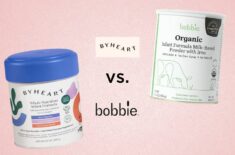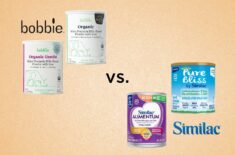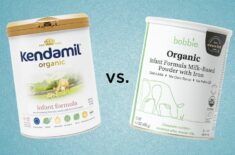Overview
At what age can you introduce your baby to certain foods in BLW (baby-led weaning)?
In general, you can choose any food to give your baby at any age, as long as it’s not a choking hazard and doesn’t have safety issues.
BLW is a feeding approach that lets your baby eat healthy finger foods at their own pace, even if it’s their first time eating solids. You can even offer a chicken drumstick or ribs as their first food, as long as these are cooked until tender.
Although many parents and pediatricians are concerned about choking, studies show that infants doing BLW aren’t more likely to choke on their foods than spoon-fed babies. (1)(2)
Still, ensure that you keep choking hazards off your child’s food tray so you can reduce the risk of choking in BLW. Soft foods are preferred.
You might also be surprised that this feeding approach can help prevent picky eating and obesity. (3)
Just be sure to ask for your pediatrician’s approval before giving solid foods to a child before they’re six months old.
Are you wondering about the best baby foods you can give in BLW? Can you give finger foods at six months, and how many times should your baby eat? Can your child eat scrambled eggs, peanut butter, oatmeal, and purées in BLW?
We prepared this handy guide to help you find answers to common BLW questions about food according to your baby’s age.
What Is Baby-Led Weaning?
BLW is a feeding approach conceptualized by Dr. Gill Rapley, who co-wrote “Baby-Led Weaning: Helping Your Baby To Love Good Food” (2008) with Tracey Murkett.
She explains that BLW can help your child develop good eating habits, improve their fine motor skills, and learn to interact with others because they’re included in family meals. (3)
Can You Overfeed In BLW?
Babies control everything in BLW, so there may be little chance that you’ll overfeed them.
In this feeding approach, your child can learn more about the sensation of hunger and fullness. So, they can self-regulate their meals.
They eat what they want to (from the BLW foods you prepared), how much of it they need, and stop when they’re full.
Visual cues of fullness can include:
- Throwing food from their tray (4)
- Slowing the pace of self-feeding
- Playing with food
What Age Is Good For Baby-Led Weaning?
BLW pioneer Dr. Rapley believes that this feeding approach may be ideal if your child is already six months old. This can help ensure they’re truly ready to eat and safely feed themselves. (5)
Still, she also acknowledges that some babies develop earlier than others.
She explains that there’s no right or wrong age to start baby-led weaning. However, always make sure your child is truly ready for it.
Some babies can be ready for solids by four months of age.
It’s important to check for signs of readiness, which can include the following:
- Sitting up on their own
- Exhibiting neck strength (can control their head)
- Showing interest in food (opens mouth, tries to grab, or leans forward when they see food)
- Using jaw movements swallow or move food to the back of their mouth
- Doesn’t push their tongue out when you put food in their mouth
But always ensure that if your baby is under six months old, you first seek your pediatrician’s recommendation before starting solids.
What Food Does BLW Start With?
Dr. Rapley doesn’t have a specific list of foods for you to give your child as they begin BLW. Instead, she suggests providing your child with a variety of foods from different food groups.
Because iron is important in your baby’s growth and development, Dr. Rapley recommends offering your child opportunities to choose iron-rich foods.
But always leave it up to your child to pick up the food and eat it.
She explains:
“All the majority of babies need, from around six months, is the opportunity to eat foods that are rich in iron at least once each day. That way they can start to increase their iron intake naturally, as soon as their body tells them they need to.” (6)
It’s a good idea to start with soft foods when introducing your child to BLW.
Feeding your child with one food per meal can also help you rule out foods that can trigger an allergic reaction.
But you don’t actually have to skip puréed foods. You can let your baby use purées as dips, or they can feed themselves using their fingers or a spoon.
In BLW you skip feeding your baby with a spoon, and instead you can let them self-feed with spoons or their hands.
Food For All Ages
Fruits & Vegetables
These fruits and vegetables can be a good source of nutrients for your baby at all ages:
- Berries
- Avocados
- Peach
- Pears
- Plum
- Apple
- Nectarine
- Melon
- Mango
- Yellow squash
- Carrots
- Zucchini
- Cucumber
- Broccoli florets
- Bananas
- Green beans
- Peas
- Beets
- Butternut squash
You can serve fruits raw if they’re ripe and soft, but cook hard fruits and veggies until tender to avoid the risk of choking. Never serve raw apple to babies under one year old.
Meat & Fish
Beef, pork, , poultry, eggs, and fish are great sources of proteins and other nutrients like iron.
But make sure to check for possible safety concerns with these protein sources to avoid choking hazards:
- Cook foods thoroughly until soft and tender.
- For fish, carefully check for bones and spines.
- For meat, carefully check for bone fragments and loose tissues.
- To reduce the risks of your child swallowing the bone part, it might be a good idea to offer meat (beef, chicken, etc.) on a bone, such as drumsticks or ribs.
Eggs can be a good baby-led weaning first food because they’re versatile.
But talk with your pediatrician before giving eggs to your baby because it’s a common allergen.
Grains & Carbohydrate Sources
Some grains, including wheat and barley, can contain gluten, a common allergen. Check the label if you want to avoid foods with gluten.
It’s also good to consult your pediatrician before introducing foods with gluten to your baby, especially if they have known food allergies.
Try to avoid choosing rice over oatmeal or other grains because rice can contain high levels of arsenic. This toxic chemical can reduce your child’s cognitive function and lead to a lower IQ. It might also cause certain cancers. (7)
Safety note: The CDC (Centers for Disease Control and Prevention) considers grains a choking hazard. (8)
Although grains are small, they’re eaten together. A big lump of grain can still be a choking hazard.
It’s also possible for the tiny grains to get aspirated into your child’s airways while they eat, causing possible choking.
Introducing Allergens
The AAP (American Academy of Pediatrics) and NIAID (National Institute of Allergy and Infectious Diseases) recommend the early introduction of allergens, particularly peanuts, at around six months to help prevent the development of food allergies. (9)(10)(11)
Studies show that the early introduction of other common allergens, including eggs and milk, in infancy can also help prevent food allergies. (12)
But be sure to consult with your little one‘s pediatrician or an allergologist before introducing them to these allergens.
Also, remember that a whole peanut can be a choking hazard. Peanut butter can be a good option for peanut allergen introduction, but ensure that it’s not too thick. Add some breast milk or water for a thinner consistency.
Baby-Led Weaning Foods By Age
Some babies might be ready for solid foods at four months of age, but many are fully ready for BLW only when they reach six months.
Others, especially premature babies and those with medical issues, might need a little more time to fully develop before they can start on solid foods.
Many premature babies might only be ready if they’re around six months from their original due date, not from their actual birth date.
You can find our recommendations for BLW foods arranged by age below. But these aren’t absolute rules.
Your baby still has the final say on whether they’ll try these foods out or not (from foods you offered), and you can always provide them with any food from the other age groups.
BLW Foods At Four Months
Fine Motor Skills
Your child might rake things with their fingers instead of grasping them at this stage. It’s a skill that can later become important as they self-feed.
Some babies might have developed the palmar grasp at this stage. It’s a skill that lets them grab food using all their fingers together.
You might notice that they’ll grab food and try to nibble off the end that sticks out of their hand.
Developmental Milestones
At this age, your baby might already show the following: (13)
- Copies facial expressions and movements
- Uses hands and eyes to find a toy and reach for it
- Recognizes familiar people
- Brings hands or toys to mouth
- Holds head steady
Meeting Nutrition Requirements
Continue with milk feeds (breastfeeding or formula), especially at this age.
In BLW, children get to explore food and try to feed themselves. But if they can’t do it yet, that’s fine. They might be more likely to just lick on the food and explore its texture or flavor at this stage.
Some babies might eat around ½ to 1 tbsp of solid meal per meal.
Never force your child to eat or take a bite from any food they manage to grab.
Foods To Offer
To reduce choking hazards, foods to offer at this stage must be soft enough for you to squish between your fingers easily.
Some examples are:
- Avocado
- Banana
- Butternut squash (cooked until tender)
Avoid foods that are too slippery for your little one to grasp, even if they’re also soft. It can be frustrating for your baby to try grabbing on food that keeps slipping out of their fingers.
Some examples of slippery foods can include:
- Ripe mangoes
- Jelly
It’s also important to avoid hard foods like hot dogs, whole nuts, and dried fruits like raisins and dates.
You can keep first foods simple, especially for infants below six months old.
Also, consult with your pediatrician before starting your child on solid foods, particularly if your baby is still below six months of age.
BLW Foods At Five Months
Fine Motor Skills
Babies develop at different rates. Don’t worry if your child isn’t sitting up at this age. Only introduce them to solids when they’re ready.
For babies around six months old and below, it might be better to serve larger pieces of food that they can easily grab. They can simply munch on the part that sticks out of their hand.
They’re likely to still use the palmar grasp to grab food at this age. If they can’t feed themselves yet, don’t worry about it.
Dr. Rapley reminds parents and caregivers that “achievements” are adults’ goals, not the child’s.
“If she doesn’t manage to get the food to her mouth, so what? She hasn’t ‘failed’ – and she has no sense of needing help.
Her parents’ role is to give her the OPPORTUNITY to do whatever she is ready to do, whether that be touching food, picking it up, licking it, biting it, chewing it and/or swallowing it – or none of the above – not to enable her to do something she can’t yet manage.” (5)
Developmental Milestones
At this age, your baby might already show the following: (13)
- Smiles spontaneously at people
- Begins to babble
- Copies sounds they hear
- Follows people or things moving with their eyes
- Pushes down on their legs when feet are put on a solid surface
- Pushes up elbows if lying on their stomach
Meeting Nutrition Requirements
Dr. Rapley reminds parents that weaning, whether BLW or spoon-feeding, shouldn’t replace breast milk (or formula) for babies, especially if they’re younger than six months old. (14)
Instead, you provide your child with opportunities to choose complementary foods to add nutrients to their milk feeds.
Continue giving formula or breastfeeding even when your baby starts eating more solid foods.
Foods To Offer
Some examples of foods you can offer at this age can include the following:
- Bananas
- Avocados
- Soft-cooked veggies (potatoes, sweet potatoes, carrots, or butternut squash)
- Eggs
- Beef
- Chicken
- Lentils
- Green beans
- Sardines
- Salmon
- Quinoa
- Oatmeal
- Vitamin C rich fruits (like papaya, berries, and apples)
- Beans
- Yogurt
Berries, apples, fish (with bones), and tough meat can be choking hazards.
You can do the following before giving these foods to your child:
- Always cut or smash berries.
- Cook hard fruits like apples, vegetables, lentils, beans, or meat until tender.
- Remove bones and spines from fish.
Eggs are common allergens. Consult with your pediatrician about early allergen introduction before giving them to your baby.
What Can I Feed My 6-Month-Old With Baby-Led Weaning?
Fine Motor Skills
Most babies can sit up unaided by six months of age. You might still need to assist them, but you’ll notice they’re sitting longer without support at this stage.
Only give solid foods if your baby can sit up without assistance. This can help provide them with a safer and easier food experience.
At this age, your child might still use their palmar grasp to hold the food with all their fingers.
Babies have a gag reflex that keeps them from choking on objects they might put in their mouths. But this reflex is gradually reduced as your child grows.
By this age, your child might have already lost their strong gag reflex. It’s another important indication that they’re ready for solid foods if they still haven’t started at an earlier age.
Developmental Milestones
At this age, your baby might already show the following: (15)
- Knows familiar faces
- Makes sounds in response to sounds
- Brings things to their mouth
- Rolls over in both directions
- Shows curiosity about things around them
Meeting Nutrition Requirements
Whether your child started earlier or it’s their first time eating solids, give them only soft foods at this age.
Also, continue giving them breastmilk or formula even if they’re already eating solid foods.
Iron-rich foods like red meat are important for 6-month-old babies.
Many babies might only eat around 1 tbsp of solid foods at this age. This amount could slightly increase if they started weaning earlier.
However, you can’t really measure how much your baby is eating in BLW. Instead, you can plan on giving them a few slices of food, then just add some more if they still want to eat.
Can My 6-Month-Old Have Scrambled Eggs?
Yes. Scrambled eggs can be an easy-to-make yet nutrient-dense food to prepare for your 6-month-old baby.
But check with your pediatrician before introducing your child to eggs, especially if they have known food or milk allergies.
Studies show that early introduction of allergens such as eggs can help keep your child from developing allergies in the future. (12)
Can You Give Finger Foods To Babies At 6 Months?
Yes. Baby-led weaning promotes letting your child eat finger foods from the beginning of their feeding milestone with solid foods.
Children might not start on solids at the same age, but most children can be ready for solid foods when they’re six months old. But always make sure they’re showing signs of readiness before starting them on solids.
Consult with your little one’s pediatrician if you have questions or concerns about their first solids.
How Many Times A Day Can I Feed Solids To My 6-Month-Old?
If they’re new to eating solids, it might be a good idea to only give your child solid foods once a day. A 6-month-old child might eat around once or twice a day.
You can gradually increase the meals to three times a day, depending on your baby’s lead.
Dr. Rapley recommends letting your baby join family mealtimes in BLW. So, it’s essential to time your baby’s feeding schedule with your regular meals.
BLW Foods At Seven Months
Fine Motor Skills
As they grow older, you’ll notice that your child becomes more adept in feeding themselves.
For example, your 7-month-old child might already know how to pick up small pieces of food with their thumb and index finger. That’s called pincer grasp.
Developmental Milestones
At this age, your baby might already show the following: (15)
- Begins to stand without support
- Learns to support weight on legs and bounce while standing
- Looks around at things near them
- Shows curiosity and reach for things far away
- Responds to own name
Meeting Nutrition Requirements
The closer your baby gets to their first birthday, the less frequently you’ll probably serve them formula or breastmilk. But milk feeds remain an important nutrition source to your child until then.
They’re likely to show some signs of food preferences at this age. But continue adding variety to your child’s diet. You can give foods with different textures and flavors.
Still, always keep in mind that you need to avoid choking hazards such as hard foods.
Foods To Offer
Some new foods to offer can include the following:
- Apricots
- Parsnips
- Pumpkin
- Toast with avocado or nut butters
- Gluten-free breadsticks
- Unsalted oatcakes
- Steamed tofu strips
- Chicken meat
- Beef, pork, turkey, or chicken
- Asparagus
- Veggie fritters or nuggets
- Veggie mini muffins
- Pancakes
- Hummus
- Cheese
Because cheese is a product made from milk, check first with your pediatrician if your child has a dairy allergy.
BLW Foods At Eight Months
Fine Motor Skills
Your child might have already mastered the pincer grasp by eight months.
Some babies can already hold utensils at this age or practice using one.
BLW promotes finger foods, but if your child wants to use a spoon like the rest of the family, you can also support them.
But again, don’t hold the spoon and feed them. Instead, demonstrate how it’s done so they can mimic it.
Developmental Milestones
At this age, your baby might already show the following: (15)
- Recognizes their name
- Begins babbling and making sounds
- Responds to other people’s emotions
- Likes looking at themselves in the mirror
- Sit up on their own (from lying down), without support
- Passes things between their hands
Meeting Nutrition Requirements
Your infant might be ready to eat two to three meals a day at this age.
But remember that your child is the central figure in baby-led weaning. They decide how many times they’ll eat.
Still, you can put them in their high chair and give them some food during family mealtimes. It’s up to them whether they’d get some food to eat or not.
Foods To Offer
If you haven’t already, you can introduce your child to the following foods at this age:
- Peaches
- Pears
- Butternut squash
- Pumpkin
- Tofu
- Chicken
- Fish
- Red meat
Many babies have some teeth at this age, but the incisors (front teeth) are usually the first ones to grow. They can begin cutting up a small piece of food more efficiently with their new teeth.
Still, make sure that the foods you serve are soft. They might have some incisors, but babies still use gums for chewing. Tough foods remain a choking hazard at this stage.
BLW Foods At 9-12 Months
Fine Motor Skills
Most babies at this age are already experts at grasping food with their palms or using their pincer grasp to hold smaller items. Others might already know how to use a spoon to feed themselves.
Self-feeding can be easier now that your child has improved hand-eye coordination and dexterity.
However, don’t worry if your child is only just starting on food at this age. Every child is different; some might develop longer than others.
Developmental Milestones
At this age, your baby might already show the following: (16)
- Understands “no”
- Clings to favorite adults
- Has favorite toys
- Picks up things with thumb and index fingers
- Sits without support
- Pulls self to stand up
- Crawls
- Copies gestures and sounds
Meeting Nutrition Requirements
As they near their first birthday, your child can begin to eat foods that older kids and adults can. But it’s still important to keep their foods tender to avoid choking risks.
Many kids this age might already show a preference for certain foods. Just continue introducing them to a wider range of food options and textures.
Also, make sure they continue drinking breastmilk or formula even if they might already eat three times a day.
Foods To Offer
If you haven’t already, you can introduce these foods to your child:
- Blueberries, raspberries, strawberries, and other berries
- Cherries
- Figs
- Grapes
- Melon
- Papaya
- Kiwi
- Orange, grapefruits, and watermelon
- Asparagus
- Aubergine or eggplant
- Beetroot
- Broccoli
- Cauliflower
- Mushrooms
- Green beans
- Leeks
- Onions
- Lentils
- Potato
- Turnips
- Spinach
- Sweet corn
- Tomatoes
- Beef
- Pork
- Eggs
- Chicken
- Salmon
- Quinoa
- Buckwheat
- Flax
- Millet
- Yogurt
- Cream cheese
- Cottage cheese
- Cheese sticks
- Peas
- Ground meat
But still, make sure to check for choking hazards and ask your pediatrician’s advice if you’re unsure whether a certain food can be alright for your child.
BLW Foods For 12 Months Old And Above
Fine Motor Skills
They might have already mastered self-feeding by hand at this stage. Some toddlers can also show interest in using cutlery like the rest of the family.
You can give them a baby-safe silicone spoon to practice on.
Developmental Milestones
At this age, your baby might already show the following: (17)
- Shyness to strangers or unfamiliar people
- Cries when parents or favorite people leave
- Shows fear in certain situations
- Responds to requests
- Uses simple gestures like waving and nodding or shaking head
- Calls parents’ or family members’ names
- Copies gestures
- Finds hidden things
- Starts to use things properly (drinking from a cup, brushing their hair, using a spoon, etc.)
- Follows simple instructions
- Pulls up and stands alone
- Gets up and walks without help
- Pokes things with their index finger
Meeting Nutrition Requirements
They’re becoming more active at this age, so offer more foods with carbohydrates to fuel their crawling adventures.
Kids over one year old can already drink cow’s milk, but breast milk and toddler formulas might still be a better choice.
Children in their first year shouldn’t drink pure cow’s milk because it has high concentrations of proteins and minerals that young tummies can’t digest yet. (18)
Foods To Offer
Most babies can already eat any food at this stage.
By now, your baby eats like a pro and has more teeth for chewing on some foods like raw apples.
But even with teeth, be sure to check for any choking hazards in your baby’s food. And make sure you’re with them throughout the meal.
Summary & Recommendations
Some babies might be ready for solid foods at four months of age, while most are fully ready for BLW only when they reach six months.
Our recommendations for BLW foods above aren’t absolute rules.
You can always provide your child with any food from the other age groups.
These are simply suggestions that you can follow, but always ensure that their foods are soft and free from choking hazards.
Also, consult with your pediatrician before starting your child on solid foods, particularly if your baby is still below six months of age.
Still, in BLW, your little one has the final say on whether they’ll try these foods out or not. But it’s good to give them a nudge in the right direction by offering healthy food options. You’re doing great, mama!
Introducing Drinking Cups
Encourage your little one to drink from an open cup instead of a sippy cup because the hard tip can affect tongue development, leading to possible speech and swallowing problems. (19)
They might already be adept with self-feeding at this age, especially if they started earlier than six months.
Start introducing them to a drinking cup. Just ensure that the cup isn’t full.
How To Let Baby Self Feed Purées
- Put some puréed food in a small bowl. Let them explore the food and put their fingers in their mouth.
- You can also scoop puréed food with a spoon and put the filled utensil on your child’s tray. They can pick it up and put it in their mouth if they’re interested.
REFERENCES
(1) https://www.ncbi.nlm.nih.gov/pmc/articles/PMC6202902/
(2) https://pubmed.ncbi.nlm.nih.gov/27647715/
(3) http://www.rapleyweaning.com/assets/Defining_BLW_v2.pdf
(4) http://www.rapleyweaning.com/assets/Throwing_food.pdf
(5) http://www.rapleyweaning.com/assets/How_early_is_too_early.pdf
(6) http://www.rapleyweaning.com/assets/Iron.pdf
(7) https://www.fda.gov/files/food/published/Arsenic-in-Rice-and-Rice-Products-Risk-Assessment-Report-PDF.pdf
(8) https://www.cdc.gov/nutrition/infantandtoddlernutrition/foods-and-drinks/choking-hazards.html
(9) https://publications.aap.org/aapnews/news/12250
(10) https://www.niaid.nih.gov/sites/default/files/addendum-peanut-allergy-prevention-guidelines.pdf
(11) https://www.nih.gov/news-events/news-releases/nih-sponsored-expert-panel-issues-clinical-guidelines-prevent-peanut-allergy
(12) https://www.ncbi.nlm.nih.gov/pmc/articles/PMC4046529/
(13) https://www.cdc.gov/ncbddd/actearly/milestones/milestones-4mo.html
(14) http://www.rapleyweaning.com/assets/Breastmilk_vs_solids.pdf
(15) https://www.cdc.gov/ncbddd/actearly/milestones/milestones-6mo.html
(16) https://www.cdc.gov/ncbddd/actearly/milestones/milestones-9mo.html
(17) https://www.cdc.gov/ncbddd/actearly/milestones/milestones-1yr.html
(18) https://www.healthychildren.org/English/ages-stages/baby/formula-feeding/Pages/Why-Formula-Instead-of-Cows-Milk.aspx
(19) https://leader.pubs.asha.org/do/10.1044/sippy-cups-3-reasons-to-skip-them-and-what-to-offer-instead/full/












